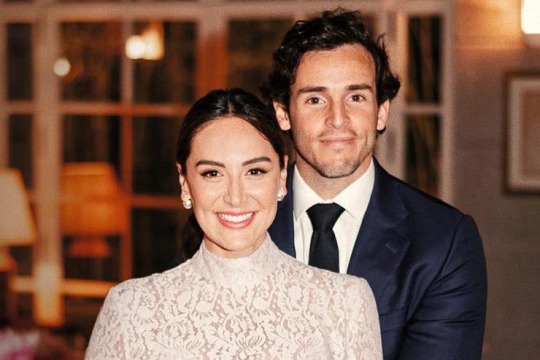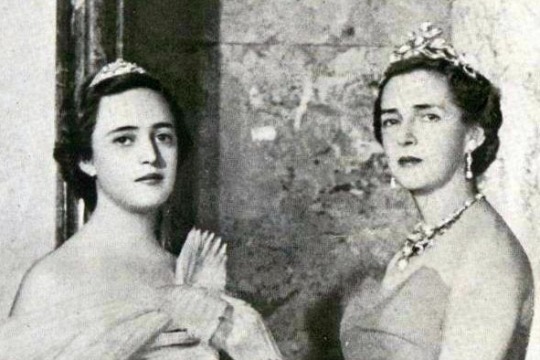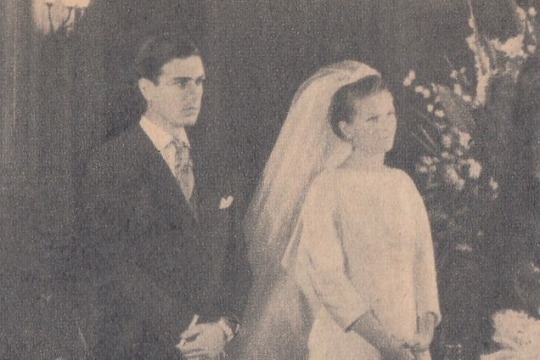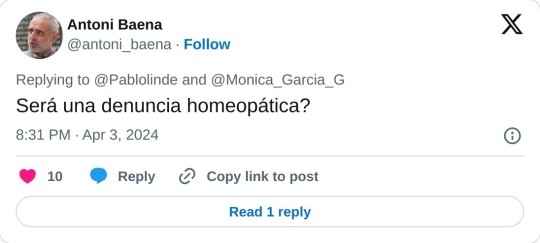#isabel preysler
Explore tagged Tumblr posts
Photo

THE MOTHER
Julio Jose Iglesias Preysler; Chabeli Iglesias Preysler; Isabel Preysler Arrastia, formerly Marchioness of Griñon; and Enrique Iglesias Preysler
#the mother#isabel preysler#enrique iglesias#chabeli iglesias#julio jose iglesias#marchioness of griñon#marquesa de griñón#españa#spaim#spanish aristocracy#spanish nobility#philippines#royal#royals#royalty#royaltyedit
6 notes
·
View notes
Text
LA DESPEDIDA DE VARGAS LLOSA
Con una novela y un ensayo sobre Sartre el Nobel anuncia su despedida ADIÓS CON MÚSICA Vargas Llosa nos ha sorprendido con el anuncio de su adiós a la literatura tanto como con el tema de su última (y definitiva) novela, la música popular del Perú. En “Le dedico mi silencio” (Alfaguara) propone, superpuestos en una alternancia que ya practicó en obras anteriores, un ensayo sobre las…

View On WordPress
#Alan García#Alberto Fujimori#Belaúnde Terry#Isabel Preysler#Jean-Paul Sartre#Julia Urquidi#Vargas Llosa
0 notes
Text
from the great controversy over the mansion to the alleged suicide attempt
ISabel Preysler (73 years old) has taken a liking to appearing on television. His last ‘cameo�� took place a few weeks ago, on the celebrity home renovation show ‘The Iglesias Brothers at workdriven by his children They were weak y Julio Iglesias Jr. The siblings went to their house in Puerta de Hierro to restore the Asian bamboo and teak furniture in the garden, which was in poor condition after…
1 note
·
View note
Text
Tamara Falco's Wedding Tiara

Tamara Falcó Preysler, the 6th Marchioness of Griñón, is marrying Íñigo Onieva Molas tomorrow at Palacio de el Rincón in Madrid and she helpfully already told us which of her family's tiaras she is going to wear! Thanks to @duchess-of-lara for telling me about it because I didn't even realize the wedding was back on after the couple broke up last year. Tamara is a Spanish socialite and TV presenter notable for being the daughter of Isabel Preysler and the sister of Enrique Iglesias.
Tamara has chosen to wear the Montellano Diamond Tiara that was made in the 1920s for her grandmother, Hilda Fernández de Córdoba y Mariátegui, 12th Marchioness of Mirabel, 3rd Countess of Santa Isabel, 10th Countess of Berantevilla, who was married to Manuel Falcó y Escandón, 9th Duke of Montellano, 11th Marquess of Castel-Moncayo, 9th Marquess of Pons, so there's a lot of titles in the family and I don't even think that's all of them. In my opinion, Spain has the best system when it comes to noble titles because they have equal primogeniture meaning women can inherit in their own right and are not skipped over for their younger brothers. Also, if you have more than one you can cede the lesser titles to your younger children so Tamara is the third child of her father but he left her the Griñón title because there were other titles that his older two children were inheriting.
María del Rocío Falcó y Fernández de Córdoba, Countess of Berantevilla, wore the tiara for her debut ball in 1950. Her mother, Hilda, who was the original owner of the diamond tiara, is wearing the Turquoise Bowknot Tiara that was made by Chaumet in 1891 for her own mother-in-law, Carlota Maximiliana de Escandón y Barrón. The top of the tiara has been altered since then and I'm not sure which member of the family owns it now but they loan it out for exhibitions sometimes.

Jannine Girod del Avellanal wore the tiara at her wedding to Carlos Falcó y Fernández de Córdova, 12th Marquess of Castel-Moncayo, 5th Marquess of Griñón, in 1966.

Carla Pía Falcó y Medina, 10th Duchess of Montellano, wore the tiara at her wedding to Jaime Matossian y Osorio in 1981. Carla also appears to own the Wild Rose Tiara made by Chaumet in 1922 but I don't know if it has a longer history in the Falcó family.

Amparo Corsini Montero wore the tiara at her wedding to Manuel Falcó y Girod, 13th Marquess of Castel-Moncayo, in 1999. Manuel is Tamara's brother and the current owner of the diamond tiara.

There's also the Montellano Pearl & Diamond that was worn by Tamara's sister, Alejandra Falcó y Girod, 13th Marchioness of Mirabel, at her wedding to Jaime de Carvajal y Hoyos, 17th Marquess of Almodóvar del Río, in 1998 and was worn last year by Isabelle Junot at her wedding to Álvaro Falcó Chávarri, 4th Marquess of Cubas. I think the diamond tiara is the right choice. It has a long history in the family and looks like it would be the easiest to wear.
#Tiara Talk#Tamara Falco#Marchioness of Grinon#Spain#Spanish Aristocracy#Spanish Nobility#diamond#bridal tiara#Duchess of Montellano#Countess of Berantevilla#Marchioness of Castel-Moncayo#Marchioness of Mirabel#I'm always tempted to not translate the titles from Spanish to English like I do with other languages#They just sound so much better in Spanish#Marquesa de Grinon#Duquesa de Montellano#Marquesa de Mirabel#Marquesa de Castel-Moncayo#Condesa de Berantevilla#duchess of lara
74 notes
·
View notes
Text
Wild how her dating history mimics Isabel Preysler’s. I forgot she used to date Luis Miguel.
But how did she meet Frederic? It’s such a weird cross-over.
24 notes
·
View notes
Text
El Premio Nobel de Literatura dejó a su prole un millonario legado gracias a su extensa trayectoria profesional.

Mario Vargas Llosa falleció el pasado 13 de abril a los 89 años en Lima, la capital de Perú. Entonces, fueron sus propios hijos quienes sacaron a la luz la amarga noticia a través de un comunicado, en el que además hacían saber la última voluntad del novelista, ensayista y Premio Nobel de Literatura, quien pidió un entierro íntimo y ser incinerado. Han pasado tres semanas desde entonces y, ahora, se ha conocido que sus tres hijos, Morgana, Gonzalo y Álvaro, están a punto de repartir el legado millonario que le dejó su progenitor.
Gracias a sus obras literarias, sus trabajos periodísticos y sus conferencias por el mundo, el escritor peruano acumuló un patrimonio que ronda los 10 millones de euros. La mayor parte de su fortuna está invertida en bienes inmuebles. Y es que el Premio Nobel de Literatura contaba con cinco lujosas propiedades distribuidas en diferentes partes del mundo.
Una de las viviendas se encuentra en Lima, en concreto, en el distrito de Barranco. Consagrada como su refugio, esta vivienda cuenta con unas espectaculares vistas al mar. Además de pasar los últimos años de su vida en este hogar, tras su separación de Isabel Preysler, en su interior albergaba buena parte de su inmensa biblioteca.
Su segundo hogar se encontraba en España. Hablamos del piso en un edificio decimonónico del Madrid de los Austrias, ubicado en el centro de la ciudad. Con unas dimensiones de 293 metros cuadrados y 39 m² de terraza, esta vivienda también fue su domicilio habitual durante sus estancias en España.
Otros los inmuebles se ubica en París, en concreto, en el barrio de Saint-Sulpice, una zona que ha sido una inspiración clave en su obra. La cuarta vivienda se encuentra en un rascacielos de Nueva York y, por último, también cuenta con una residencia vacacional en Punta Cana. Cabe destacar que cada uno de estos inmuebles se encuentra dotado con todo tipo de lujos que respondían a las necesidades del novelista.
Por si fuera poco, en España también tenía domiciliada la empresa que gestionaba sus derechos de autor. Él mismo se había puesto, como administrador, un salario de 1,1 millones de euros anuales. Ahora, serán sus hijos quienes se harán cargo del legado construido por Mario Vargas Llosa. Además de este millonario patrimonio, el mayor de sus hijos, Álvaro, le lega también su título nobiliario de marqués Vargas Llosa, que le fue concedido en el año 2011 por el rey Emérito Juan Carlos I.
Una enfermedad incurable
La relación del escritor con sus hijos pendía de un hilo tras su separación de Patricia Llosa. Sin embargo, tras conocer que fue diagnosticado de una enfermedad terminal para la que solo existía tratamiento paliativo, Mario Vargas Llosa quiso recuperar su relación con su prole. Lo primero que hizo al recibir el diagnóstico fue escribir una carta a sus tres hijos.
Aunque por entonces este aún mantenía una relación con Isabel Preysler, dichos escritos terminaron por unir a la familia. En 2022, se separó de la reina de los corazones y volvió con la madre de sus hijos. A partir de entonces, se trasladó de nuevo a Perú para estar al lado de su familia.
F: Infobae
0 notes
Text
youtube
👉 a Video that taught us all that you should never steal money from Mickey Rourke… unless your the girl, nothing at all happened to her… now Enriquel on the other hand … anyhow
Happy Birthday. Today, May 8, 1975 #EnriqueIglesias is born in Madrid, Spain, to Spanish singer Julio Iglesias and journalist Isabel Preysler.
0 notes
Text
“Llegará tarde”: El lamentable gesto de Tamara Falcó tras el fallecimiento de Mario Vargas Llosa, expareja de su madre Isabel Preysler
https://www.elegimaldia.es/llegara-tarde-el-lamentable-gesto-de-tamara-falco-tras-el-fallecimiento-de-mario-vargas-llosa-expareja-de-su-madre-isabel-preysler/
0 notes
Text
0 notes
Text
La machine à régénération cellulaire, le présentateur TV et la ministre de la santé.
Mónica García, ministre espagnole de la santé, s'est pris une plainte pour incitation à la haine de la part d'une association représentant les professionnels des "thérapies naturelles."
Et tout ça a commencé avec un people qui a vante en public un dispositif anti-vieillissement.



Pablo Motos, un célèbre animateur et producteur de TV espagnol, a récemment annoncé, avec beaucoup d'enthousiasme, qu'il avait enfin pu trouver la machine anti-vieillissement dont il avait tant entendu parler.
Il était donc tout contente de tester cette machine, dans une luxueuse clinique d'Alicante.
Émerveillé, par cet "appareil de régénération cellulaire", il s'empresse de publier une vidéo, en compagnie d'une toubib. La vidéo, très élogieuse, fait le buzz.
...Et finit par entraîner cette réaction de la ministres espagnole de la santé, Mónica García, sur Twitter.

L'effet des pseudo-thérapies se limite au porte-monnaie, dans le meilleur des cas. L'absence de preuves scientifiques n'est pas seulement une tromperie : parfois, cela met aussi la santé en danger.
Une association de professionnels de la "santé naturelle", la Cofenat ("Asociación Nacional de Profesionales y Autónomos de las Terapias Naturales"), a alors décidé de porter plainte contre la ministre, pour incitation à la haine.
Ce qui a soulevé pas mal de réactions.
Un journaliste a relevé qu'il était étrange que ces gens se sentent visés par les propos de la ministre, lorsqu'elle écrivait "pseudo-thérapies", eux qui se décrivent comme "thérapeutes naturels". Cette dernière a d'ailleurs ironisé sur Twitter en se demandant on ne pourrait pas dire qu'il s'agit là d'une "pseudo-plainte".

Et ce responsable universitaire s'est lui demandé si ce ne serait pas une plainte homéopathique.

Autre réaction, celle d'une association de défense des consommateurs, FACUA. Cette association a annoncé avoir interpellé par écrit les autorités compétentes pour dénoncer le présentateur TV, mais aussi le médecin qui apparaît à ses côtés dans la vidéo qu'il a diffusé sur les réseaux sociaux, faisant la promotion de cette supposée machine à "régénération cellulaire".
Nous verrons bien ce qu'il adviendra de la plainte visant la ministre.
Mais j'aimerais finir par une petite réflexion politique et une remarque quelque peu chauvine.
Parce que oui, de temps en temps, j'aime bien me permettre un petit coup de patriotisme.
Regardez donc ce tweet.

Lisez. Réfléchissez. Elle se prend donc une plainte pour ça.
Cette femme est donc ministre de la santé dans le gouvernement présidé par Pedro Sánchez. Un socialiste. Elle même fait partie de "Sumar", une coalition de partis à la gauche de la gauche.
Et elle se positionne comme ça.
Je conclus donc avec une petite pensée pour les habitants d'un pays qui se situe au nord des Pyrénées, où, en matière de santé, les leaders de gauche les plus médiatisés sont soit fans de Vandana Shiva soit fans de Didier Raoult...
Voilà, c'était ma petite conclusion.
Je vous l'ai dit : de temps en temps, j'aime bien me permettre un petit coup de patriotisme...

1 note
·
View note
Text
tvrundown USA 2023.12.05
Tuesday, December 5th:
(exclusive): Stavros Halkias: "Fat Rascal" (netflix, stand-up comedy), "Isabel Preysler, My Christmas" (dsn+, Spanish special), "The Melodic Blue" (amazon, Baby Keem music video, 20mins), The Ultimate Gift Wrapping Challenge (QVC+, competition premiere, first 2 eps), "Geddy Lee Asks: Are Bass Players Human Too?" (Para+, musicians docu-series, all 4 eps)
(streaming weekly): Love Like a K-Drama (netflix, next 3 eps), The Boulet Brothers' Dragula (Shudder|AMC+), A Murder at the End of the World (hulu), My Home Hero (hulu), Tokyo Revengers (hulu)
(also new): TMZ's "Merry Elfin' Christmas" (FOX, year-in-review special), "Great Photo, Lovely Life" (HBO, family secrets documentary, ~2hrs)
(hour 1): NCIS: Sydney (CBS), The Voice (NBC, 2hrs), Dancing With the Stars (ABC|dsn+, 3hrs), Name That Tune (FOX), Inside the NFL (theCW)
(hour 2): The Oval (BET), Whose Line Is It Anyway? (theCW), Wipeout (TBS), Hard Knocks: In Season (HBO), The Voice (NBC, contd), Dancing With the Stars (ABC|dsn+, contd)
(hour 3): Fargo (FX), FBI True (CBS), Found (NBC), Frontline (PBS, "Inside the Uvalde Response"), Dark Side of Comedy (Vice, "Ellen DeGeneres"), Dancing With the Stars (ABC|dsn+, contd, season 32 finale)
(hour 4 - latenight): The Graham Norton Show (BBCAm, season 31 contd, new night)
1 note
·
View note
Text
Tuesday, December 05, 2023 Canadian TV Listings (Times Eastern)
WHERE CAN I FIND THOSE PREMIERES? GEDDY LEE ASKS: ARE BASS PLAYERS HUMAN TOO? (Paramount +) GREAT PHOTO, LOVELY LIFE (HBO Canada) 10:00pm
WHAT IS NOT PREMIERING IN CANADA TONIGHT TMZ'S MERRY ELFIN' CHRISTMAS (Fox Feed) LIFE BELOW ZERO: FIRST ALASKANS (TBD - Nat Geo Canada) REAL TIME CRIME (TBD - Investigation Discovery)
NEW TO AMAZON PRIME CANADA/CBC GEM/CRAVE TV/DISNEY + STAR/NETFLIX CANADA:
AMAZON PRIME CANADA AFTER AFTER EVER HAPPY
DISNEY + STAR ISABEL PREYSLER: MY CHRISTMAS (Season 1)
NETFLIX CANADA THE F WORD JUMANJI: WELCOME TO THE JUNGLE STAVROS HALKIAS: FAT RASCAL TOP CHEF (Seasons 6 & 12)
NHL HOCKEY (SN1/SNPacific) 7:00pm: Kings vs. Blue Jackets (TSN5) 7:00pm: Rangers vs. Sens (SNEast/SNOntario) 7:30pm: Red Wings vs. Sabres (SNWest) 9:00pm: Wild vs. Flames (SNPacific) 10:00pm: Devils vs. Canucks
NBA BASKETBALL (TSN4/TSN5) 7:30pm: Knicks vs. Bucks (SN1) 10:00pm: Suns vs. Lakers
THIS HOUR HAS 22 MINUTES (CBC) 8:00pm
MARY MAKES IT EASY (CTV Life) 8:00pm: Life is a Fryway
EVIDENCE OF THE UNEXPLAINED (T&E) 8:00pm (SERIES PREMIERE): The UFO story continues worldwide, as evidenced by an object emerging from the sea at Miami; a witness in Australia suffering mysterious injuries; and 60 schoolchildren in Zimbabwe describing an encounter with an object and its occupants.
DERELICT RESCUE (Cottage Life) 8:00pm (SERIES PREMIERE): Isadora and Ben undertake the restoration of a 500-year-old farmhouse; they battle decades of decay, missed deadlines and vanishing funds to transform the estate into a grand manor with bonus rental spaces.
COMFORT FOOD WITH SPENCER WATTS (CTV Life) 8:30pm: Spencer provides some twists on a few originals including his version of meat tourtiere pies, a Newfoundland-inspired bundt pan figgy duff with maple syrup liqueur, and west coast salmon rolls.
THE LAZARUS PROJECT (Showcase) 9:00pm: The team gets closer to cracking the science behind time travel, but the mission is not as straightforward as it appears, while George witnesses the repercussions of unlimited time travel.
911 CRISIS CENTER (Lifetime Canada) 9:00pm/9:30pm (SERIES PREMIERE): Dispatcher Essence Sullins and the night shift team take non-stop emergency calls from 6 p.m. to 6 a.m., including one that connects to someone in Essence's family. In Episode Two, on her last shift at CVD, veteran 911 dispatcher Christine Mazzeo must navigate the chaos of St. Patrick's Day and say goodbye to the work family she has been with through thick and thin for over 12 years.
CHRISTINE SINCLAIR'S FINAL MATCH: CANADA VS. AUSTRALIA (TSN/TSN3/TSN4/TSN5) 10:00pm
#cdntv#cancon#canadian tv#canadian tv listings#this hour has 22 minutes#mary makes it easy#comfort food with spencer watts#the lazarus project#nhl hockey#nba basketball#soccer
0 notes
Text
Ricardo Bofill, the son-in-law who ran out of Isabel Preysler's patience long before Íñigo Onieva
“When I went in there they gave me three months to live”. The speaker is Ricardo Bofill Jr., son of the prestigious architect who bears the same name. He did so in 2002 from a suite with a terrace at the top of the Quirón Clinic in Barcelona. He had been hospitalized for about two weeks. His addictions, those that his brother had only just found out about, had gotten out of hand. It was time to…
0 notes
Text
Ante mi DESEMBARCO más q probable en SAN JUAN DE LUZ x mi año 52 [28_11_23] ..recuerdo q ahi nació Miguel BOYER "SALVADOR" al exiliarse su familia por GUERRA CIVIL..fue famoso x ser MINISTRO DE ECONOMIA HACIENDA SOCIA_LISTA del gobierno del CAMBIO de FELIPE GONZALEZ [amigo del mexicano más RICO Carlos SLIM q veranea en AVION un pueblo de Galicia] y expropiar el grupo RUMASA [q construyó como sede las TORRES GEMELAS "COLON" al reves o de arriba a abajo] del Supernumerario del OPUS DEI Ruiz MATEOS q se vistió de Superman para protestar [incluso agredió a BOYER antes las camaras] y puso a su mujer MADRE de 13 hijos como PRESIDENTA del RAYO VALLECANO..mientras q BOYER tras 20 años se divorcio de Elena ARNEDO [ una médica ginecóloga, escritora, política y activista por los derechos de las mujeres en España, pionera en la defensa de los derechos sexuales y reproductivos e impulsora de los primeros centros de planificación familiar que se crearon en España a principios de los años 1970..También fue pionera en la prevención del cáncer de mamá muriendo ella de uno de pulmon. En las elecciones municipales ocupó el puesto número tres en las listas del PSOE que encabezó Trinidad Jiménez asumiendo desde la oposición Igualdad y Asuntos Sociales además de ser la viceportavoz del grupo municipal socialista. Cesó como concejala en mayo de 2004, pasando su acta a Pedro Sánchez Pérez-Castejón, actual presidente de Gobierno.]..para casarse con ISABEL PREYSLER o ex_mujer de JULIO IGLESIAS..
..después se salio de PSOE para militar en el partido de FERNANDEZ ORDOÑEZ q como ministro de JUSTICIA impulso ley del DIVORCIO y fue gran artífice de la Entrada en ESPAÑA en la UNION EUROPEA muriendo de CANCER con 62 años en 1992 o año en el q se conmemoró el V CENTENARIO DEL DESCUBRI_MIENTO DE AME_RICA con la EXPO UNIVERSAL DE SEVILLA ..exactamente 7 agosto 1992 en plenos JJOO BARCELONA '92

0 notes
Text

Isabel Preysler en navidad o como ser forever young
0 notes
Text
youtube
👉 *a Video that taught us all that you should never steal money from Mickey Rourke… unless your the girl, nothing at all happened to her… now Enriquel on the other hand … anyhow
Happy Birthday. Today, May 8, 1975 #EnriqueIglesias is born in Madrid, Spain, to Spanish singer Julio Iglesias and journalist Isabel Preysler.
( https://en.wikipedia.org/wiki/Enrique_Iglesias )
0 notes